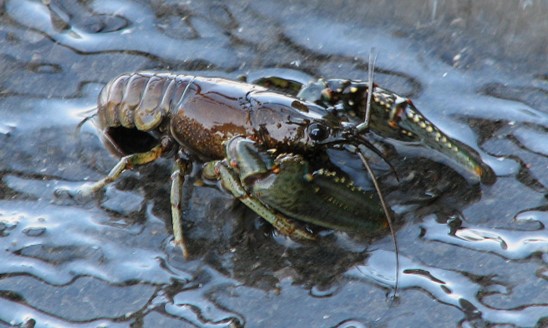Infosheet: Paragonimus kellicotti for veterinarians
To download a PDF of this document, please click here: https://www.oahn.ca/wp-content/uploads/2022/05/Lung-Fluke-factsheet-vF-20220503.pdf
Lung flukes (P. kellicotti) in dogs and cats
In North America, the most common lung fluke affecting dogs is the trematode Paragonimus kellicotti. The parasite can be found throughout the Mississippi and Great Lakes waterways. Pets cannot spread the parasite directly to humans. People can be infected the same way as dogs but infection in people with P. kellicotti is very rare compared to other Paragonimus species.
Transmission
The natural definitive host of P. kellicotti is mink. Infected animals pass fluke eggs in their feces. In an aquatic environment, the parasite follows a complex life cycle involving snails and freshwater crayfish. Immature forms can also survive free in water for days. Mink, as well as other animals including dogs, cats and people, are typically infected by eating raw (or undercooked) crayfish, or eating other small animals (e.g. rodents) that feed on crayfish.

Once ingested, the immature flukes are released and migrate from the intestinal tract through the body until they reach the lungs, where they mature into adults and form cysts in the bronchioles after 2-3 weeks. Fluke eggs are coughed up, swallowed and passed in the feces. The prepatent period is approximately 5-7 weeks (in cats).
Clinical signs
Clinical signs of infection can range from none or a mild cough to varying degrees of dyspnea. In severe cases animals may develop bronchiectasis, hemoptysis, or spontaneous pneumothorax.
Diagnosis
Detection of P. kellicotti eggs in the feces typically requires fecal sedimentation, as sensitivity of routine fecal floatation is poor. Eggs can also be detected on transtracheal wash in some cases. Eggs have a brown shell with a distinct operculum on one end, and are approximately 75-118 x 42-67 um in size.
Cysts in the lungs may be noted on thoracic radiographs or CT, and can be an incidental finding in subclinical cases. The flukes have a predilection for the right lung.
Peripheral eosinophilia may also be present.
Treatment
There are no drugs available in Canada or the US with a label claim for treatment of P. kellicotti in dogs or cats; however, praziquantel (23 mg/kg PO q8h for 3 days), or fenbendazole (50 mg/kg PO q24h for 10-14 days) are reported to be effective. Treatment with either drug may need to be repeated in some cases to fully eliminate the infection.
- Treatment with praziquantel PO in cats can be problematic due to the bitter taste of some formulations, and may be cost-prohibitive in large dogs.
Treatment is recommended even in subclinical cases due to the risk of the infection leading to acute pneumothorax. Uncomplicated infections generally respond well to antiparasitic treatment. In severe cases, lung lobectomy may be required.
Prevention
- Avoid contact with aquatic environments where crayfish are present.
- Do not allow pets to consume crayfish or other animals that consume crayfish.

Additional information
- https://vcahospitals.com/know-your-pet/lung-fluke-infections-in-dogs
- https://www.merckvetmanual.com/respiratory-system/respiratory-diseases-of-small-animals/lung-flukes-in-dogs-and-cats
- https://www.aavp.org/wiki/trematodes-2/trematodes-lungs/paragonimus-kellicotti/
- Peregrine AS, et al. Paragonimosis in a cat and the temporal progression of pulmonary radiographic lesions following treatment. J Am Anim Hosp Assoc. 2014 Sep-Oct;50(5):356-60. doi: 10.5326/JAAHA-MS-6053. PMID: 25028442.

